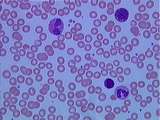The Health Education Assets Library (HEAL) is a collection of over 22,000 freely available digital materials for health sciences education. The collection is now housed at the University of Utah J. Willard Marriott Digital Library.
1 - 25 of 4
| Title | Description | Subject | Collection | ||
|---|---|---|---|---|---|
| 1 |
 |
Blood | Due to their biconcave disc shape, erythrocytes appear to have a pale center. Small lymphocytes are roughly the same size as erythrocytes (7-8 microns). Platelets are cytoplasmic fragments of bone marrow megakaryocytes. Identify the three types of granulocytes: Neutrophil nuclei usually consist of 3... | Basophils; blood; lymphocytes; Neutrophil; Platelets | UCLA Histology |
| 2 |
 |
Blood | Erythrocytes or RBCs are devoid of organelles. Platelets often appear in clumps. Neutrophil nuclei assume many shapes; also note the sparse purple cytoplasmic granules. Monocytes are the largest leukocytes, and often display a large kidney-shaped nucleus. Because monocytes and neutrophils phagocytiz... | blood; Erythrocytes or RBCs; Monocyte; Neutrophil | UCLA Histology |
| 3 |
 |
Blood | Erythrocytes are roughly the same size as small lymphocytes. Lymphocytes have round, dark nuclei and a small basophilic cytoplasm. Lymphocytes account for roughly 30% of leukocytes, but this percentage can dramatically increase during viral infection. Neutrophils are the most abundant, comprising ab... | blood; Lymphocytes; Neutrophil | UCLA Histology |
| 4 |
 |
Blood | Note the clumped erythrocytes and platelets. Two neutrophils and one basophil. Basophils account for less than 1% of leukocytes. Granules of basophils are quite large and dark; they often make it impossible to see the bilobed nucleus. UCLA Histology Collection. | basophils; blood; Neutrophil; platelets | UCLA Histology |
1 - 25 of 4
